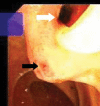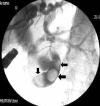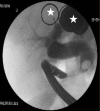Ectopic Opening of Common Bile Duct into Duodenal Bulb and Gastric Antrum and Its Importance
- PMID: 37542403
- PMCID: PMC10685873
- DOI: 10.34172/aim.2022.110
Ectopic Opening of Common Bile Duct into Duodenal Bulb and Gastric Antrum and Its Importance
Abstract
Background: Ectopic opening of the common bile duct (CBD) is extremely rare, and its importance has not been adequately defined. The aim of our study is to present the characteristics of patients with this abnormality.
Methods: This retrospective study was conducted in a tertiary center in Dicle University Hospital, Diyarbakır, Turkey, between October 2008 and December 2020. We present clinical, laboratory, endoscopic and cholangiographic features as well as the success rate of therapeutic interventions of consecutive patients with this abnormality undergoing endoscopic retrograde cholangiopancreatography (ERCP).
Results: Ectopic opening of the CBD was identified in 29 (21 men; mean age 62) out of 3872 (0.74%) patients. There was a history of cholecystectomy in 14 (48%) and recurrent acute cholangitis in 20 (69%) patients. We found peptic ulcer in 13 (45%) and duodenal deformity associated with apical stenosis in 21 (72%) patients. Opening site was seen as abnormal in all patients, and it opened into the antrum in 2 (6.8%) and into the first part of the duodenum in 27 (93%) patients. Copious amount of bile and/ or bile sediment in the stomach were seen in all patients. We observed dilatation in both intrahepatic and extrahepatic bile ducts together with tapered narrowing and a hook-shaped distal end of CBD in all patients. There was bile stone in 26 (89%) and sludge in 3 (10%) patients. Sphincterotomy was not performed in any patients because there was not enough incision distance. Balloon dilatation was performed for extraction of stone and sludge in all patients. Complete stone extraction was achieved in only 7 out of 26 (27%) patients.
Conclusion: Ectopic opening of CBD is usually associated with gastroduodenal and bile ducts disease. Endoscopic treatment is unsatisfactory in most patients with this abnormality.
Keywords: Cholangitis; Common bile duct; Ectopic opening.
© 2022 The Author(s). This is an open-access article distributed under the terms of the Creative Commons Attribution License (https://creativecommons.org/licenses/by/4.0), which permits unrestricted use, distribution, and reproduction in any medium, provided the original work is properly cited.
Conflict of interest statement
The authors declare that they have no conflict of interest.
Figures
Similar articles
-
Anomalous opening of the common bile duct into the duodenal bulb: endoscopic treatment.BMC Gastroenterol. 2007 Jul 5;7:26. doi: 10.1186/1471-230X-7-26. BMC Gastroenterol. 2007. PMID: 17610747 Free PMC article.
-
Retrospective analysis of cases with an ectopic opening of the common bile duct into duodenal bulb.Adv Clin Exp Med. 2018 Oct;27(10):1361-1364. doi: 10.17219/acem/69691. Adv Clin Exp Med. 2018. PMID: 30062869
-
Ectopic Opening of Common Bile Duct to Duodenal Bulb: A Single Tertiary Center Experience.Surg Laparosc Endosc Percutan Tech. 2023 Dec 1;33(6):640-644. doi: 10.1097/SLE.0000000000001219. Surg Laparosc Endosc Percutan Tech. 2023. PMID: 37725829
-
The clinical presentations of ectopic biliary drainage into duodenal bulbus and stomach with a thorough review of the current literature.BMC Gastroenterol. 2010 Jan 12;10:2. doi: 10.1186/1471-230X-10-2. BMC Gastroenterol. 2010. PMID: 20064279 Free PMC article. Review.
-
Duplication of the extrahepatic bile duct: A case report and review of the literatures.Medicine (Baltimore). 2018 Feb;97(8):e9953. doi: 10.1097/MD.0000000000009953. Medicine (Baltimore). 2018. PMID: 29465584 Free PMC article. Review.
References
MeSH terms
Substances
LinkOut - more resources
Full Text Sources






